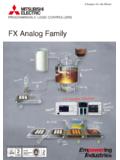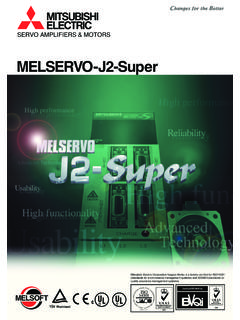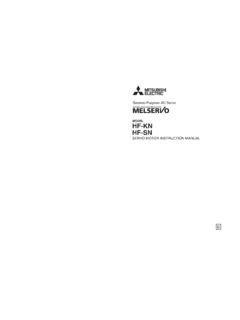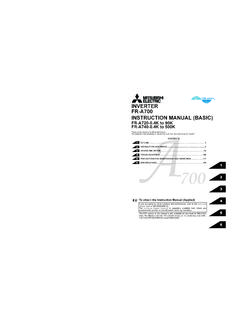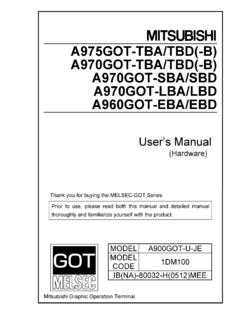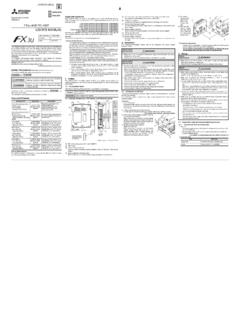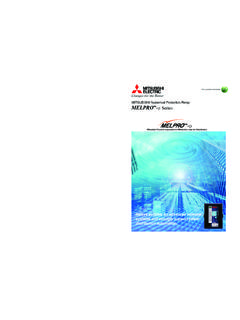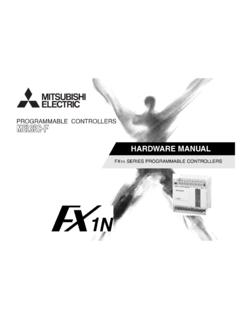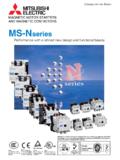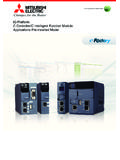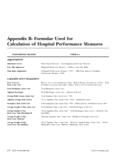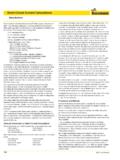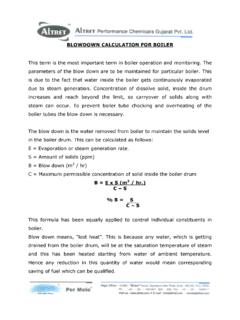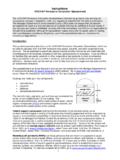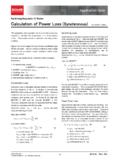Transcription of Technical Note No.31 CAPACITY SELECTION II …
1 INVERTER Technical NOTE No. 31 CAPACITY SELECTION II [ calculation PROCEDURE] (CONTINUOUS OPERATION) (CYCLIC OPERATION) (LIFT OPERATION)INVERTER SH-060004 ENG-B(1009)Specifications subject to change without notice. CONTENTS CHAPTER 1 DEFINITION OF OPERATION PATTERNS AND FUNDAMENTAL CONCEPTS FOR CAPACITY SELECTION .. 1 1. 1 Definition of operation patterns .. 1 1. 2 Fundamental concepts for CAPACITY 1 1. 3 Applicable inverter and motor series .. 2 CHAPTER 2 SELECTION PROCEDURE .. 3 2. 1 SELECTION 3 2. 2 Symbols of the loads/operations required for the CAPACITY SELECTION .. 6 CHAPTER 3 CONTINUOUS 7 3. 1 calculation of load-driving power and load torque.
2 7 3. 2 SELECTION of motor and inverter capacities (tentative).. 8 3. 3 Assessment for the 3. 4 Assessment for the continuous 3. 5 Assessment for the acceleration ..14 3. 6 Assessment for the deceleration ..15 3. 7 Regenerative power calculation ..17 CHAPTER 4 CYCLIC OPERATION ..19 4. 1 calculation of load-operating power and load 4. 2 SELECTION of motor and inverter capacities (tentative)..20 4. 3 Assessment for the 4. 4 Assessment for the low-speed and high-speed operations ..23 4. 5 Assessment for the acceleration ( calculation of the total acceleration torque)..24 4. 6 Assessment for the deceleration ( calculation of the deceleration torque).
3 27 4. 7 Regenerative power calculation (temperature calculation of the braking option)..29 4. 8 Temperature calculation of the motor and 4. 9 Stop accuracy ..36 CHAPTER 5 LIFT OPERATION ..37 5. 1 calculation of required power and load 5. 2 SELECTION of motor and inverter capacities (tentative)..38 5. 3 Assessment for the 5. 4 Assessment for the low-speed and high-speed operations ..40 5. 5 Assessment for the 5. 6 Regenerative power calculation (temperature calculation of the braking option)..46 5. 7 Temperature calculation of the motor and 5. 8 Stop accuracy ..55 CHAPTER 6 SELECTION EXAMPLE FOR CONTINUOS OPERATION ( SELECTION EXAMPLE FOR A CONVEYOR).
4 56 CHAPTER 7 SELECTION EXAMPLE FOR CYCLIC OPERATION ( SELECTION EXAMPLE FOR A BOGIE) ..59 CHAPTER 8 SELECTION EXAMPLE FOR LIFT OPERATION (LIFT WITH COUNTERWEIGHT)..67 Technical Notes to were integrated as this document. This Technical Note targets the 500 series inverters. For the earlier models, refer to Technical Notes to -1-CHAPTER 1 DEFINITION OF OPERATION PATTERNS AND FUNDAMENTAL CONCEPTS FOR CAPACITY SELECTION Definition of operation patterns Operations patterns are categorized into the following two patterns based on their operation time: the long-duration operation at constant speed is called "Continuous operation," and the repeated short-duration operation is called "Cyclic operation" (repetition of start constant-speed operation deceleration to stop).
5 Lift operation is a part of Cyclic operation. The main characteristic of Lift operation is that it has different loads according to the rotation direction. Two loads, the positive load (normally when ascending) and the negative load (normally when descending), exist. When ascending/descending, the regenerative power for the negative load requires special attention. Operation patterns are categorized by the following operation conditions : Operation pattern Number of starts/stops (operation period) Load condition Continuous operation Less than 10 times/h Positive load Cyclic operation 10 times/h or more Positive load Lift operation 10 times/h or more Positive load and negative load Necessary documents for the SELECTION Please prepare Technical NOTE CAPACITY SELECTION [DATA] Fundamental concepts for CAPACITY SELECTION (1) The machine can start The starting torque during inverter operation should be smaller than the torque during commercial power supply operation.
6 Select appropriate capacities for the motor and inverter so that the motor can start with the small torque available during inverter operation. Especially in Lift operation, select the motor and inverter capacities that provide enough starting torque because the object may drop due to a starting torque shortage. An inverter with Advanced magnetic flux vector control or vector control, which enables torque increase at low speed, is the optimum choice. (2) The machine can run at low speed and at high speed Select appropriate motor and inverter capacities so that the motor's output torque is higher than the load torque at low and high constant-speed operation.
7 (3) The machine can accelerate/decelerate within the specified acceleration/deceleration time The motor current during acceleration/deceleration should be higher than the current during constant-speed operation. Select an inverter CAPACITY that tolerates the increased current. In addition to the load characteristics (load torque, moment of inertia, speed), the acceleration/deceleration time in the operation pattern affects the amount of current flow during acceleration/deceleration. (4) The regenerative power can be consumed During deceleration, the regenerative power must be consumed. Braking options such as a brake unit or a regenerative converter may be required.
8 For Lift operation, negative load is applied even during constant-speed operation. Consider using a brake unit or a regenerative converter. (5) The operating temperature cannot exceed the permissible temperature of the motor Check that the equivalent current of the motor torque is 100% or less and the electronic thermal relay and the transistor thermal protection are not activated. -2-(6) Mechanical safety brake must be used for lifting equipment Always use a mechanical safety brake for lifting equipment to keep the stop status of the lifted object.
9 Applicable inverter and motor series Applicable inverter series FR-A500 FR-F500 FR-E500 FR-S500 FR-V500 Applicable motor series Standard motor SF-JR, SF-HR Constant torque motor SF-HRCA Geared motor GM-D, GM-S Vector motor SF-V5R Standard motor with encoder SF-JR -3-CHAPTER 2 SELECTION PROCEDURE SELECTION flowchart (1) Continuous operation SELECTION outline Assessment Refer to page Calculate the required power and the load torque, and select a motor CAPACITY that can be driven by the required power or higher. When selecting, also check that the rated motor torque is equal to or higher than the load torque.
10 Required power : PLR = 6120 VWmax [kW] Load torque : TLR = maxNP9550LR [N m] Selected motor CAPACITY (tentative) : PM Selected rated motor torque (tentative) : TM PM PLR TM TLR 7 Select the inverter CAPACITY that is equivalent to the motor CAPACITY . If higher acceleration torque is required, select the inverter CAPACITY , which is higher than the motor CAPACITY . Selected inverter CAPACITY (tentative) : PINV PINV PM 8 Check that the starting torque of the motor is larger than the load torque at start. Maximum starting torque of the motor : TMS = TM s s : Starting torque coefficient : Hot motor coefficient Load torque at start : TLS TMS > TLS 10 Check that the load torque is within the continuous operation torque range of the motor.
